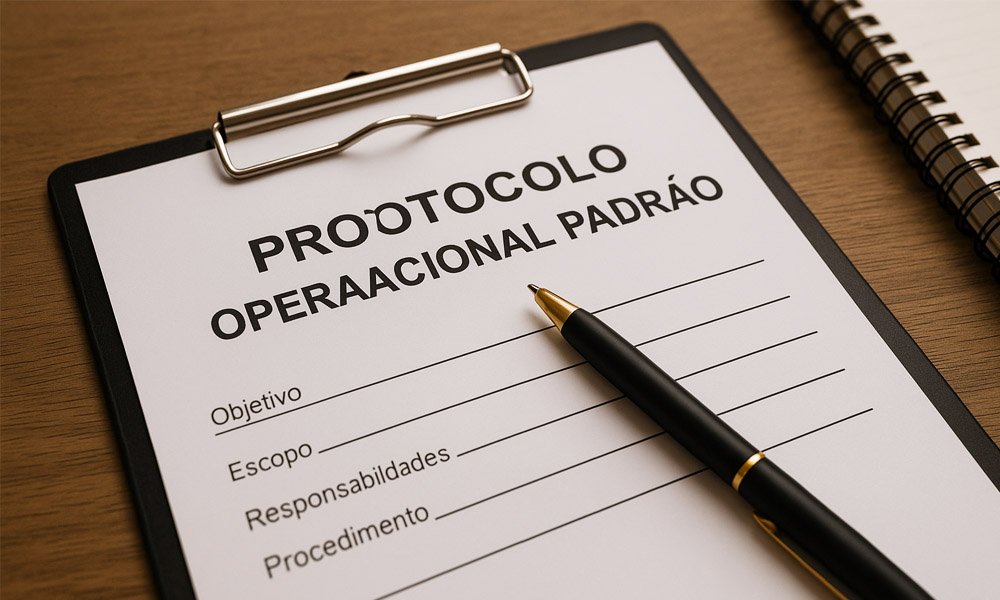Guide
What Is a Protocolo Operacional Padrão? The Simple Guide You Need
Published
5 months agoon
By
Archie
Have you ever seen a mistake at work that could have been avoided? Like someone pressing the wrong button on a machine, or skipping a safety step? These things may seem small, but they can cause big problems.
That’s why smart companies use something called a Protocolo Operacional Padrão—or POP for short. It sounds like a fancy name, but don’t worry. It’s actually very simple.
A POP is just a written guide that shows how to do a task the right way, every time. It’s used in hospitals, restaurants, offices, airports—almost everywhere. In this article, we’re going to explain exactly what a POP is, why it matters so much, and how it helps people stay safe, save time, and do great work. Let’s dive in!
What Is a Protocolo Operacional Padrão (POP)?
A Protocolo Operacional Padrão is a document that shows step-by-step how to do a task. It’s like a recipe, but for work.
Imagine you’re in a restaurant. The chef doesn’t guess how much salt to use or how long to cook the chicken. They follow a POP that tells them exactly what to do. That way, the food tastes the same every time.
The same thing happens in a hospital. A nurse giving medicine will follow a POP so they don’t miss a step or make a mistake. It keeps people safe and helps workers feel more confident.
So, in simple words: a POP is a clear set of rules that helps people do their job safely, correctly, and with less stress.
Why Every Business Needs a POP
No matter the size of a business—big or small—a POP helps everything run better.
Without a POP, people may do things in different ways. One person might clean a machine one way, and another might skip a step. That can lead to problems like accidents, wasted time, or even serious mistakes.
But with a POP:
-
Everyone follows the same steps.
-
New workers can learn faster.
-
Managers can check if the job is done right.
It’s like giving every worker a simple map to follow. That way, no one gets lost or confused.
Where POPs Are Used in Real Life
You might be surprised how many places use POPs every single day.
In hospitals, POPs are used for things like washing hands, cleaning wounds, or giving injections. This keeps patients safe and healthy.
In factories, POPs help workers handle tools or machines the right way. This stops damage and helps workers avoid injuries.
In restaurants, POPs explain how to clean the kitchen, cook meals, or store food safely.
In airports, POPs guide staff through safety checks, boarding rules, and emergency steps.
Even small offices use POPs for things like customer service, email replies, or filing documents. It keeps work smooth, fast, and clear.
What a Good POP Looks Like
A POP only works well if it’s written clearly and is easy to follow.
Here’s what a good POP includes:
-
A title that shows what the task is.
-
A short goal (for example, “How to clean the coffee machine”).
-
A list of who does what.
-
Any tools or materials needed.
-
A step-by-step guide written in simple words.
-
Safety tips if the task is risky.
-
The date it was last updated.
Think of it as a helpful checklist. Not too long, not too hard—just the right amount of detail to make the job easier and safer.
The Main Parts of a POP Document
Let’s take a closer look at the key parts inside a Protocolo Operacional Padrão:
-
Title and version – So people know which task it covers.
-
Objective – A few words to explain the goal.
-
Scope – Who should use this POP and where.
-
Responsibilities – Who is in charge of each step.
-
Instructions – Clear steps, in the right order.
-
Tools and materials – What you need to do the job.
-
Safety notes – How to protect yourself and others.
-
Review date and signatures – So it stays up to date.
When all of this is included, the POP becomes a very helpful tool, not just a boring paper.
Step-by-Step: How to Create a POP
Making a Protocolo Operacional Padrão might sound hard, but it’s really just about paying attention and writing things down clearly.
Here’s how it usually works:
-
Step 1: Choose a task that happens often or needs to be done safely.
-
Step 2: Watch how it’s done right now. Look for steps people forget or do differently.
-
Step 3: Talk to the people who do the task every day. They know the details best.
-
Step 4: Write down the steps clearly, using simple language. Avoid big words or confusing terms.
-
Step 5: Test it! Ask someone new to follow the steps and see if they understand.
-
Step 6: Show it to a manager or team leader and get approval.
-
Step 7: Train the team and put the POP in a place where everyone can see it.
Now, the job can be done the right way—every single time.
Common Problems with POPs (And How to Fix Them)
Even though a Protocolo Operacional Padrão is helpful, sometimes things go wrong. The most common problem is that people don’t follow the POP. Why? Maybe the instructions are too long or hard to understand. Or maybe no one explained why the POP is important.
Another issue is when the POP becomes outdated. If tools change or a task is updated, the POP must be changed too. If not, workers may use old steps that no longer work or are unsafe.
To fix this, keep POPs short and clear. Use easy words. And don’t just give people the paper—train them. Explain why it matters. Also, choose someone to check and update the POP regularly so it always stays useful.
How POPs Help with Safety and Laws
POPs are not just about doing things right—they’re also about staying safe and following the law. In some industries, using a Protocolo Operacional Padrão is not a choice—it’s required.
For example, in hospitals, there are health laws that demand written rules for how to clean tools or care for patients. In the food industry, companies must follow strict hygiene steps, or they can be fined or shut down. POPs help make sure all these rules are followed every day.
So when you see a POP, think of it as a shield. It protects workers, customers, and the business from accidents, mistakes, and legal problems.
POPs in a Digital and AI World
In 2025, POPs are not just on paper. Many companies use digital POPs. You can find them on tablets, phones, or work computers. Some even have checklists you can tap as you go.
Big companies now use AI (artificial intelligence) to help update POPs. For example, if a machine keeps breaking, the AI might suggest a better order of steps. This makes the Protocolo Operacional Padrão smarter and more useful over time.
Also, new tools like videos, voice guides, or alerts help people follow POPs in real-time. This is very helpful in factories, warehouses, or outdoor work where reading a long paper isn’t easy.
Real-Life Example: POPs During the COVID-19 Crisis
During the COVID-19 pandemic, POPs saved time and lives. Hospitals, stores, schools, and airports had to quickly write new POPs to stay safe.
Think about it: new rules were needed for wearing masks, cleaning hands, keeping distance, and checking temperatures. All of this had to be clear and easy to follow.
Places that already used POPs adapted faster. They had systems in place to create, share, and train people quickly. This showed how strong and important POPs are, even in a crisis.
How to Know If a POP Is Working
Creating a POP is one thing, but how do you know if it’s really helping?
You can check by asking simple questions:
-
Are fewer mistakes happening?
-
Are people finishing tasks faster and safer?
-
Are workers following all the steps?
Some companies also track numbers. They look at accident reports, task times, or customer complaints. If these things improve, the POP is working well. If not, it may need a change.
Also, it’s smart to ask workers: “What do you think of this POP?” Their feedback can help you make it even better.
Bottom-Line
A Protocolo Operacional Padrão may sound like just a document, but it’s much more than that. It’s a tool that helps everyone do their job better, safer, and with less stress.
When used the right way, a POP becomes part of the team. It supports new workers, avoids mistakes, and protects the business. It also saves time, money, and even lives.
So, whether you run a busy kitchen, a large hospital, or a small office, remember this: a POP is not about control. It’s about care. It’s about helping people work smarter, together.
The best organizations in 2025 are not the ones with the biggest buildings. They are the ones with clear rules, trusted people, and simple tools—like the Protocolo Operacional Padrão.
(FAQs)
Can a missing POP really shut down a business?
Yes! In health, food, or aviation industries, not having a POP can break the law and lead to heavy fines or full shutdowns.
Are POPs just for big companies?
No! Even a small shop or home bakery can use a simple POP to avoid mistakes, save time, and work smarter.
Can the wrong POP cause injuries?
Absolutely. If a POP has wrong or outdated steps, it can lead to accidents, machine damage, or even harm to people.
Do most workers actually follow POPs?
Surprisingly, many don’t. If a POP is too long, confusing, or never explained, workers often skip it, putting everyone at risk.
Can AI really write or update a POP?
Yes, in 2025 it can! Some companies now use AI to monitor tasks and suggest better POP steps automatically.
Other Articles You May Read:
You may like


Why Companies Worldwide Are Hiring Power BI Developers

Experience Pure Android Gameplay with MuMuPlayer Emulator

A Guide To Solar PV For Homeowners

How to Convert a Historic Building into a Hotel: a 2025 Guide

How You Can Integrate AI into Your Small Business For Faster Growth

File Recovery on Android: Myths vs. Facts

Cooler, Safer, Clearer: Why Quality Window Tint Is a Smart Upgrade in 2025

How Medium-Sized Businesses Actually Handle Their Books

Best Travel Vacuum Bags: Pack More and Worry Less with Vacbird Storage Bags

Start Your Morning Right: The Real Benefits of Himalayan Pink Salt and Lemon Water

Carol Kirkwood’s Journey: Her Real Age, Husband, Career, and More

Revolutionizing Healthcare: The Emergence of AI-Driven Analytics

How Machine Learning and AI are Redefining the Future?

Aliza Barber: Meet Lance Barber’s Wife, Age, Life, Profile, Career and Net Worth

Evelyn Melendez: Jordan Knight’s Wife Bio, Marriage, Family, Career and Net Worth

Ilan Tobianah Biography: Family, Marriage, Lifestyle, Career and Net Worth

Who was Alice Marrow? Everything to Know About Ice-T’s and His Mother

King Von’s Autopsy Report: The Truth Behind the Tragic Death

Meet Otelia Cox: The Supportive Wife of Tony Cox – A True Fairy Tale Romance

Tea Leoni and Tim Daly Split – A Closer Look at Their Relationship and Breakup

Why Companies Worldwide Are Hiring Power BI Developers

Experience Pure Android Gameplay with MuMuPlayer Emulator

A Guide To Solar PV For Homeowners

How to Convert a Historic Building into a Hotel: a 2025 Guide

How You Can Integrate AI into Your Small Business For Faster Growth

File Recovery on Android: Myths vs. Facts

Cooler, Safer, Clearer: Why Quality Window Tint Is a Smart Upgrade in 2025

How Medium-Sized Businesses Actually Handle Their Books

Best Travel Vacuum Bags: Pack More and Worry Less with Vacbird Storage Bags

Start Your Morning Right: The Real Benefits of Himalayan Pink Salt and Lemon Water
Category
Trending
-

 News3 months ago
News3 months agoCarol Kirkwood’s Journey: Her Real Age, Husband, Career, and More
-

 Health2 years ago
Health2 years agoRevolutionizing Healthcare: The Emergence of AI-Driven Analytics
-

 Technology2 years ago
Technology2 years agoHow Machine Learning and AI are Redefining the Future?
-

 Celebrity2 years ago
Celebrity2 years agoAliza Barber: Meet Lance Barber’s Wife, Age, Life, Profile, Career and Net Worth
